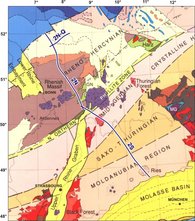Deep seismic investigations of the German Variscides from the Münsterland Basin to the Danube
The European Variscides, extending from the French Central Massif to the East European Platform, originated during the collision between Gondwana and Baltica in the Late Palaeozoic. Due to involvement of various crustal blocks in the orogenesis, the mountain belt is subdivided into distinct zones. The external fold-and-thrust belts of the Rhenohercynian (RH) and Saxothuringian (ST) as well as the predominantly crystalline body of the Moldanubian (MN) dominate the central European segment of the Variscides. Polyphase tectonic deformation, magmatism and metamorphic processes led to a complex interlinking between the units.
DEKORP 2 was designed to reveal the Variscan units from north to south. It starts in the sub-Variscan foredeep of the Münsterland Basin and ends in the Moldanubian region at the Danube. The central part crosses the Rhenish Massif (Rhenohercynian), the Spessart Mountains of the Mid-German Crystalline High (Saxothuringian) and the meteorite impact location of the "Nördlinger Ries".
The seismic survey DEKORP 2 aimed
- to image the Variscan structures in detail with respect to their specific transitions,
- to obtain evidence about vertical tectonic processes during the Variscan orogenesis,
- to understand the causes of observed gravity and magnetic anomalies,
- to recognize and define the "Variscan front" to the north,
- to make a contribution to the International Lithosphere Program (ILP) and the former European Geotraverse ( EGT), now Geophysical Institute (GPI), Karlsruhe.
DEKORP 2 consists of 3 seismic lines and was shot in two parts. The survey comprises the 250 km long, NW-SE striking profile DEKORP 2S, its northwestward continuation DEKORP 2N (220 km) and the 70 km long cross-line DEKORP 2Q near the northern end of profile 2N (see location map). Wide-angle seismic observations along and parallel to DEKORP 2S complemented the survey.
Experiments
DEKORP 2S:
The first DEKORP line, DEKORP 2S, was the only one which mainly used explosives as the seismic source. The 250 km long, NW-SE striking profile extends from the Rhenohercynian Taunus Mountains to the Danube thereby crossing the Spessart Mountains, the Hessian Trough and the "Nördlinger Ries".
DEKORP 2N/2Q:
The 220 km long, NNW-SSE striking DEKORP 2N line provides a cross-section through the Rhenish Massif from the sub-Variscan Münsterland Basin in the north - starting at the drill hole "Münsterland" - to the Rhenohercynian Taunus Mountains in the south. The profile is the northern continuation of DEKORP 2S. Line 2Q crosses line 2N perpendicularly in its northern part and extends northeastwards to the drill hole "Versmold 1".
long (start) lat (start) long (end) lat (end)
DEKORP 2S 8.51460° 50.37957° 10.73643° 48.70226°
DEKORP 2N 7.30122° 52.05130° 8.59946° 50.29243°
DEKORP 2Q 7.50128° 51.72640° 8.23361° 52.01652°



